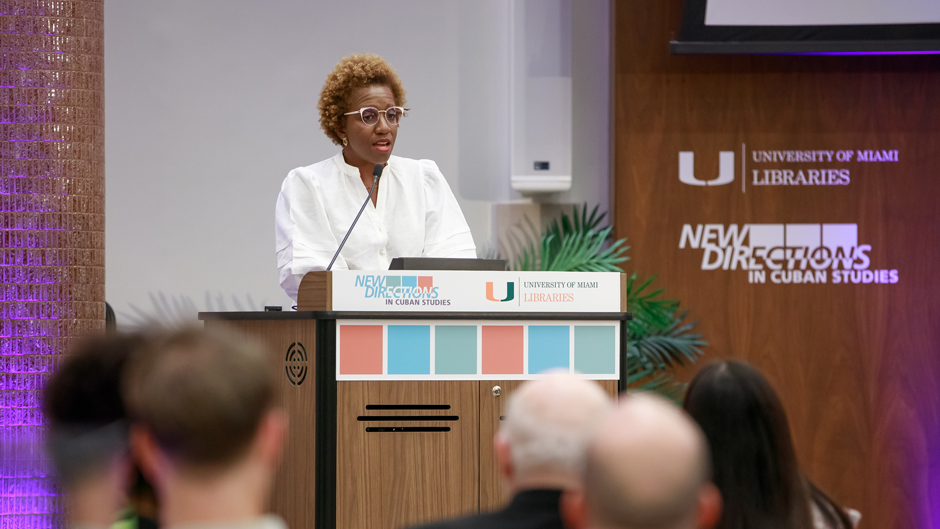Against a backdrop of cascading crisis on the island, scholars on Cuba and its diaspora shared their perspectives on Black identity, new technologies, the growing influence of African religions, music, film, and theater innovations, amidst a rainbow of other topics as part of the “New Directions in Cuban Studies Conference,” held last week at the Kislak Center in the University of Miami Libraries.
Presenters highlighted the implications of globalization and the role of emerging new voices, both in Cuba and in exile, in addressing the conference theme, “Contours of Crisis: Major Challenges for Cuba Yesterday, Today, and Tomorrow.”
Amanda Moreno, director of the Cuban Heritage Collection and Esperanza Bravo de Varona chair; Michael Bustamante, associate professor of history and Emilio Bacardi Moreau chair in Cuban and Cuban American Studies; and Lisa Fish, associate dean for Collections and Strategies for the libraries welcomed guests to the fifth edition of the conference sponsored by the Goizueta Foundation.
Odette Casamayor Cisneros, the inaugural Roberto C. Goizueta Distinguished Presidential Fellow, pondered the complicated history of race and Black identity in Cuba in her keynote address, “Deconstructing Cuban Blackness: Notes on Racialization and Nationhood in Contemporary Cuba.”
“Who am I?’ she queried. “It is said that I am Black and Cuban and also that I am Caribbean and Latin American and a Latina woman.”
Casamayor Cisneros said her ancestors, enslaved people from Africa, were considered commodities, not human beings. “So, I am a miscalculation in Western history,” she said.
In reviewing Cuba’s history on blackness, the keynote speaker emphasized that the narrative has been mostly written by members of the white intellectual elite society who positioned Blacks as inferior to their white compatriots.
To her point, she cited the early works of Cuban ethnographer Fernando Ortiz, who categorized Blacks [those who followed Afro-Cuban religions] in his early writings as “primitives” of low moral character.
She also highlighted the work of ethnographer Lydia Cabrera, who dedicated her work to documenting the Afro-Cuban religions, yet ignored the socio-economic conditions and disparities suffered by “los negritos”—as Cabrera referred to the servants at her house, who were also primary sources for her research.
The racism that existed at the founding of the republic is still prevalent in today’s world, Casamayor Cisneros added. Not only do Afro-Cubans suffer more because they have fewer relatives in the U.S. and therefore receive few remittances, but a visit to the island makes evident that Blacks are still on the lower rung of society, she shared.
On Thursday, a panel on “Income and Tactics in the Practice of Daily Life in Havana” explored the many ways that present-day Cubans deal with a worsening economic crisis that has made food, medicine, and electricity scarce.
Arisbel Lopez Andraca, a Ph.D. candidate from the University of Texas-Austin, explained how the 1992 relaxation of Cuban laws has allowed for Cubans to openly exhibit their spirituality and religious practices. Prior to 1992, practices were prohibited and heavily sanctioned by the government.
Since then, the growth of the practice of Afro-Cuban religions (such as Santeria and Palo) has increased the number of religious families—practitioners both inside and outside the island—that has allowed for exchange of goods and services, beyond the ones required for religious rituals, he said.
“In every case, the religious families play a critical role [in Cuban society],” he said. Having members of their religious family in other countries can provide a Cuban santero or palero benefits to combat the daily economic constraints on the island, Lopez Andraca said.
Lillian Manzor, associate professor and associate chair in the Michele Bowman Underwood Department of Modern Languages and Literatures, moderated the “Sounds of Crisis” session where speakers highlighted how the constraints of oppression have emerged to influence theater, documentary filmmaking, reggaeton, and women artists in fusion jazz.
Ruthie Meadows, an assistant professor of ethnomusicology with the University of Nevada-Reno, showcased a new vanguard of Cuban Black women jazz artists.
“Women such as Grammy Award winner Dayme Arocena, who follows in the tradition of La Lupe and Cecilia Cruz, offer novel forms of experiencing and experimenting the sounds of Blackness and are reconfiguring the gendered sound boundaries of Cuban jazz fusion as well as the boundaries of transnational citizenship and belonging on the island,” Meadows said.
In a conversation on the evolution of Cuban Studies with Lisandro Perez, a professor of Latin American and LatinX Studies with the John Jay College of Criminal Justice, Bustamante asked about the opportunities that emerge from focusing on the specter of crisis that has long shadowed the island.
“I don’t remember a time in which we weren’t operating in Cuban Studies without crisis, Perez said. As the former director of the Cuban Research Institute at Florida International University, Perez said he always tried to make sure there was a community of scholarship both in the diaspora and on the island.
“While there’s been crisis after crisis, still the academic enterprise manages to have survived all of that,” Perez said. “And that’s critical because it’s innate to the disposition of someone who goes into academia to ferment dialogue, communication, and tolerance for different perspectives.”

